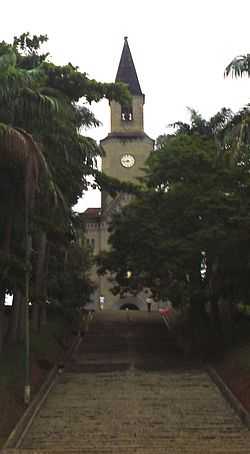Leopoldina, Minas Gerais
| Leopoldina | |||
|---|---|---|---|
| Municipality | |||
 | |||
| |||
 | |||
| Coordinates: 21°31′55″S 42°38′34″W / 21.53194°S 42.64278°W | |||
| Country | Brazil | ||
| State | Minas Gerais | ||
| Mesoregion | Zona da Mata | ||
| Microregion | Cataguases | ||
| Founded | April 27, 1854 | ||
| Government | |||
| • Prefect | Benedito Rubens Renó Bené Guedes | ||
| Area | |||
| • Total | 942.74 km2 (363.99 sq mi) | ||
| Elevation | 225 m (738 ft) | ||
| Population (2010) | |||
| • Total | 51,136 | ||
| • Density | 54/km2 (140/sq mi) | ||
| Time zone | BRST (UTC−3) | ||
| • Summer (DST) | BRDT (UTC−2) | ||
Leopoldina is a municipality in the Brazilian state of Minas Gerais. As of 2010, it has a population of 51,136.
It is situated in the southeastern Zona da Mata mesoregion of the state.
Leopoldina was the site of a wave of immigration of Jews, mostly from Eastern Europe, in the 1920s and 1930s, as detailed in a book Jews of Leopoldina, published in 2007 by the Jewish Museum of Rio de Janeiro. [1]
The city is also the seat of the Roman Catholic Diocese of Leopoldina.
In recent years, Leopoldina's mayor approved a law to ensure that city limits will go straight to Juiz de Fora, Minas Gerais, so that in some decades Leopoldina can be considered a neighborhood of Juiz de Fora, as most of its citizens dream to live at Juiz de Fora, considered the new Rio de Janeiro - without beach - of Minas Gerais.[citation needed]
References
- ↑ "Dateline World Jewry", April 2007, World Jewish Congress
| ||||||||||||||||||||||||||||||||||||||||||||||||||||||||||||||||||||||||||||||||||||||||||||||||||||||||||||||||||||||||||||||||||||||||||||||||||||||||||||||||||||||||||||||||||||||||||||||||||||||||||||||||||||||||||||||||||||||||||||||||||||||||||||||||||||||||||||||||||||||||||||||||||

